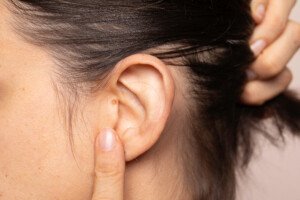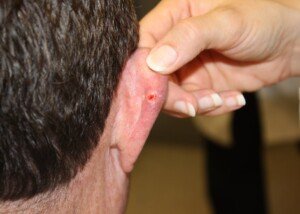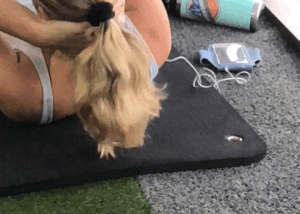
The challenge with new earlobe bumps is that they’re difficult to closely inspect when doing a monthly skin cancer exam.
The first thing you want to do is remove any hair from the ears, and this includes stray strands.
Wet your fingers with water to easily move the strands against the rest of your hair. This will keep them out of the way long enough to inspect your earlobes without visual interference of hair.
Mirrors
• You’ll need one wall mirror and a hand mirror.
• Make sure both are as clean as possible, no smudges.
• Do not get frustrated upon initially realizing how tricky it is to get a solid view of the back of your earlobe by positioning the hand mirror before the wall mirror. It will take practice.
I’ll be honest: It won’t be easy at first. But just keep trying and you’ll eventually know just how to position the mirror with one hand and gently pull back on the ear with the other to expose its backside.
• You’ll want to view the entire earlobe from a behind view, which is created by the use of mirrors.
• You’ll also want to view it from the side—again, experiment with positions to get a smack T-bone angle.
• A third position is from the front, without the use of a second mirror, just for a third perspective. Gently pull the earlobe towards you and simply view head-on.
Do not rush through the inspection, no matter how challenging.
To better view a new growth, see if wearing reading glasses might enlarge any spots yet still maintain a clear view.
If you view the area too far away while wearing reading glasses, the view will be blurry.
“When performing self-skin exams, I recommend touching the ears to try to feel for any new bumps or non-healing sores,” says Allison Arthur, MD, FAAD, board certified dermatologist with Sand Lake Dermatology Center in Orlando, FL.
“If possible, enlist a friend or family member to help keep an eye on your ears in between visits to your dermatologist for skin cancer screening exams.”
What to Look for: Suspicions of Cancer
Clinical Skin Cancer Screenings
As Dr. Arthur recommends, have a dermatologist inspect your skin (which will include the earlobes) every year, in addition to your monthly skin cancer self-checks.
If you’re especially worried about finding something suspicious whenever you check your earlobes, have your primary doctor look at them during your annual physical.
An Unlikely Identifier of a Suspicious Spot
Sometimes, a person with health anxiety will focus on a particular region of the body when it comes to skin cancer checks.
If it’s the earlobe, there’s yet another way you can get inspections: Make sure you see a dentist twice a year. Many people neglect seeing a dentist until a tooth begins aching.
Many dentists can’t help but notice earlobes and the rest of the face, scalp and neck when working on a patient.
A dentist won’t deliberately inspect an earlobe with the same scrutiny with which they inspect the inside of your mouth for cancer.
However, a dentist (or hygienist) may happen to notice a suspicious looking bump, spot or mole within their visual field as they work on you.
Furthermore, some dentists will deliberately give nearby regions a sweeping glance (not an inspection) out of habit.
Dentists have actually discovered melanoma and other skin cancers on unsuspecting patients.
It’s up to the patient to have a dermatologist make the diagnosis, but there are many instances in which the patient had no idea the “mole” or bump was there – until their dentist pointed it out. So see your dentist regularly!
Finally, like Dr. Arthur says, have a family member check your earlobes for signs of cancer, but their inspection should never replace your self-exams.

Dr. Arthur is a Mayo Clinic-trained dermatologist and dermopathologist who cares for patients of all ages, providing skin cancer and other medical/surgical treatments, plus cosmetic treatments.
 Lorra Garrick has been covering medical, fitness and cybersecurity topics for many years, having written thousands of articles for print magazines and websites, including as a ghostwriter. She’s also a former ACE-certified personal trainer.
Lorra Garrick has been covering medical, fitness and cybersecurity topics for many years, having written thousands of articles for print magazines and websites, including as a ghostwriter. She’s also a former ACE-certified personal trainer.
.









































